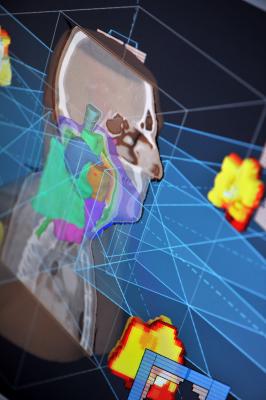
April 2, 2013 — With RayStation 3.5, RaySearch releases tools for treatment planning of radiation therapy with electrons and protons, complementing RayStation’s tools for planning and optimization of radiation therapy with photons. Proton Beam Design is a brand new module in RayStation that contains tools for treatment planning of double scattered and uniformly scanned protons, such as a clinically approved Pencil Beam dose engine and automatic generation of treat-and-protect beams.
This is the first clinical release of proton planning functionality in RayStation, to be followed by many others, such as Pencil Beam Scanning techniques and Monte Carlo dose calculations. Electron Beam Design is another entirely new module that includes a Monte Carlo dose engine for electron radiation therapy and tools for manual editing of beams similar to how it is done in the 3-D-CRT module. The functionality for Proton Beam Design and Electron Beam Design is available for installation in the European Union, Japan and Australia but is pending regulatory clearance in the USA.
RayStation 3.5 also adds new features to the existing intensity-modulated radio therapy (IMRT) and volumetric modulated arc therapy (VMAT) modules offering the possibility to perform all IMRT and VMAT delivery modes available with all relevant machines from the leading hardware suppliers. One example is the introduction of support for IMRT treatments using the DMLC delivery mode (Sliding Window). Another example is support for mARC that enables treatment planning of rotational therapy with Siemens linacs.
RayStation 3.5 also offers a wide range of new tools for improving the planning workflow and automating tedious treatment planning tasks. One example is the introduction of Plan Generation Protocols. A Protocol is a list of plan generation steps that the operator creates with a user-friendly wizard. This gives the user the possibility to create a whole treatment plan with one click. The user selects the patient and what protocol to apply, and the system can then, for example, automatically perform the structure definition using model-based segmentation, set up the beams with a pre-selected machine, optimize the plan using pre-set objectives and calculate the clinical dose. Not only does this free up time for reviewing and fine-tuning the plans, but it can also be used as a tool to ensure that all the clinic’s patients are treated consistently, leveraging the full clinical experience of the clinic.
Fallback Planning is another advanced feature that has potential to save planning time. This function provides a way to automatically generate treatment plans for alternative treatment machines and techniques, based on an existing dose distribution. This enables clinicians to swiftly switch patients from one treatment machine to another to balance the workload or as a backup, in case the designated treatment machine is unavailable at the scheduled time of a treatment.
Other major features included in RayStation 3.5 are Biological Evaluation and Biological Optimization. These give the user the opportunity to evaluate the radiobiological effect of a treatment using the most well-established radiobiological effect models or optimize the treatment based on a mix of physical and radiobiological objectives and constraints.
Furthermore, the new release includes a wide range of other highly useful features such as a new function for automatic reduction of organ-at-risk doses, tools for letting the user define MBS models and user-configurable treatment plan reports. In addition, RayStation 3.5 includes major improvements and performance enhancements that further facilitate and speed up the treatment planning process in modules such as RayPhysics, 3-D-CRT Beam Design, Treatment Adaptation, Multi-Criteria Optimization and DICOM import and export.
“RayStation takes a big leap forward to eliminate all unnecessary tedious manual steps and lets the user focus all energy on reviewing, improving and adapting the treatment plans, which are the tasks where the clinical experience matters the most”, said Johan Löf, CEO of RaySearch.
For more information: www.raysearchlabs.com


 December 11, 2025
December 11, 2025 









